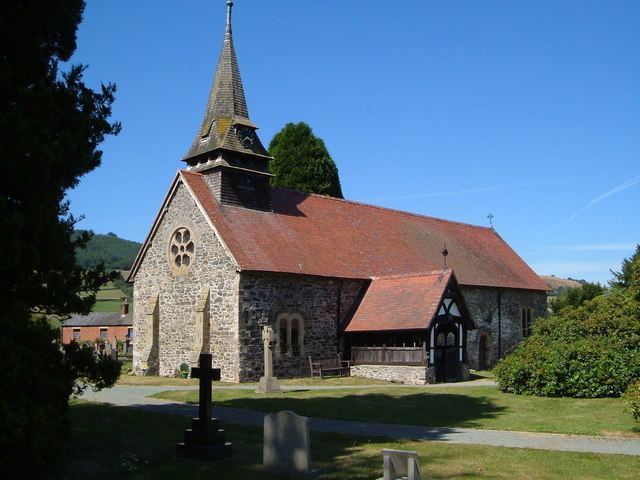Population 465 (2011) Sovereign state United Kingdom Local time Thursday 11:15 AM | Community Llanfechain Country Wales | |
 | ||
Weather 9°C, Wind NE at 21 km/h, 78% Humidity | ||
Llanfechain is a small village in northern Powys, mid Wales, between Llanfyllin and Llansantffraid-ym-Mechain on the B4393 road. Historically it was part of Montgomeryshire. Afon Cain runs through the village. It has a population of about 500.
Contents
- Map of Llanfechain UK
- Name
- Religious establishments
- Notable sites and buildings
- Notable residents
- Railway
- Education and recreation
- References
Map of Llanfechain, UK
Name
Llanfechain could mean "parish or church (llan) of the Cain valley" (from Llan ym Mach Cain meaning "church in the field or plain of the Cain" to Llan ym Mechain and then Llan-mechain, which becomes Llanfechain as a result of the common mutation of 'm' to 'f' in Welsh). However, it might also mean "small (fechan) church or parish (llan)". Spellings of placenames vary considerably over time, so small variations such as chain/cain and fechain/fechan are plausible. The name in the form Llanveccheyn is first encountered in 1254. It has also been known as Llanarmon-ym-Mechain, ym-Mechain refers to its location in the medieval cantref of Mechain, thus 'Church of St Garmon in Mechain'.
Religious establishments
The parish church, St Garmon's, was originally constructed in Norman times, and still retains many original features. It is a Grade II* listed building It is a single-chambered structure with surviving Romanesque windows in the east wall and two doorways in the south wall. There were some Victorian alterations including the addition of a western bell turret. Inside, the roof dates from the 15th century, the font is from about 1500, the pulpit carries a date of 1636, and at the western end its gallery remains.
Little is known about St Garmon. According to tradition, he lived in the 9th century and preached from a mound in the churchyard at Llanfechain. The remains of this mound, 'Twmpath Garmon' are still evident today north of the church, although graves have been dug into it. According to the recollections of 19th century villagers, recorded in Volume 5 of the Montgomeryshire Collections, cockpits were dug near to the mound for cockfighting. 'Fynnon Garmon', the Holy well associated with Garmon, lies to the south east of the village. St Garmon was most likely St Germanus (410-474), the first Bishop of Man.
Two chapels used to operate in the village: the Peniel Wesleyan Methodist Chapel (erected 1834, rebuilt 1875, Sunday School added 1901, closed about 1990 and now residential) and the Zoar Calvinistic Methodist Chapel (erected 1827, rebuilt 1914, closed 2008).
Notable sites and buildings
Notable residents
Gwerful Mechain (c. 1460 - post 1502), the only female poet of Medieval Wales from whom a substantial amount of work has survived, was the descendent of a noble family from Llanfechain.
The Welsh poet Gwallter Mechain (real name Walter Davies) was born at Y Wern, near Tomen y Castell, Llanfechain in 1761. He was the rector of the parish of Manafon and arbiter of the Eisteddfodau. He was commissioned to undertake agricultural surveys of the counties of North and South Wales between 1797 and 1815.
The novelist and playwright James Hanley lived in Llanfechain from December 1940 until 1963. After he died in London in 1985, Hanley was buried in the village.
Railway
Llanfechain was served by the Llanfyllin branch of the Cambrian Railways from 1863. The line closed in 1965 and has since been dismantled.
Education and recreation
The village has a small primary school and a village hall. A traditional village show has been held on the August Bank Holiday weekend every year since 1966.
